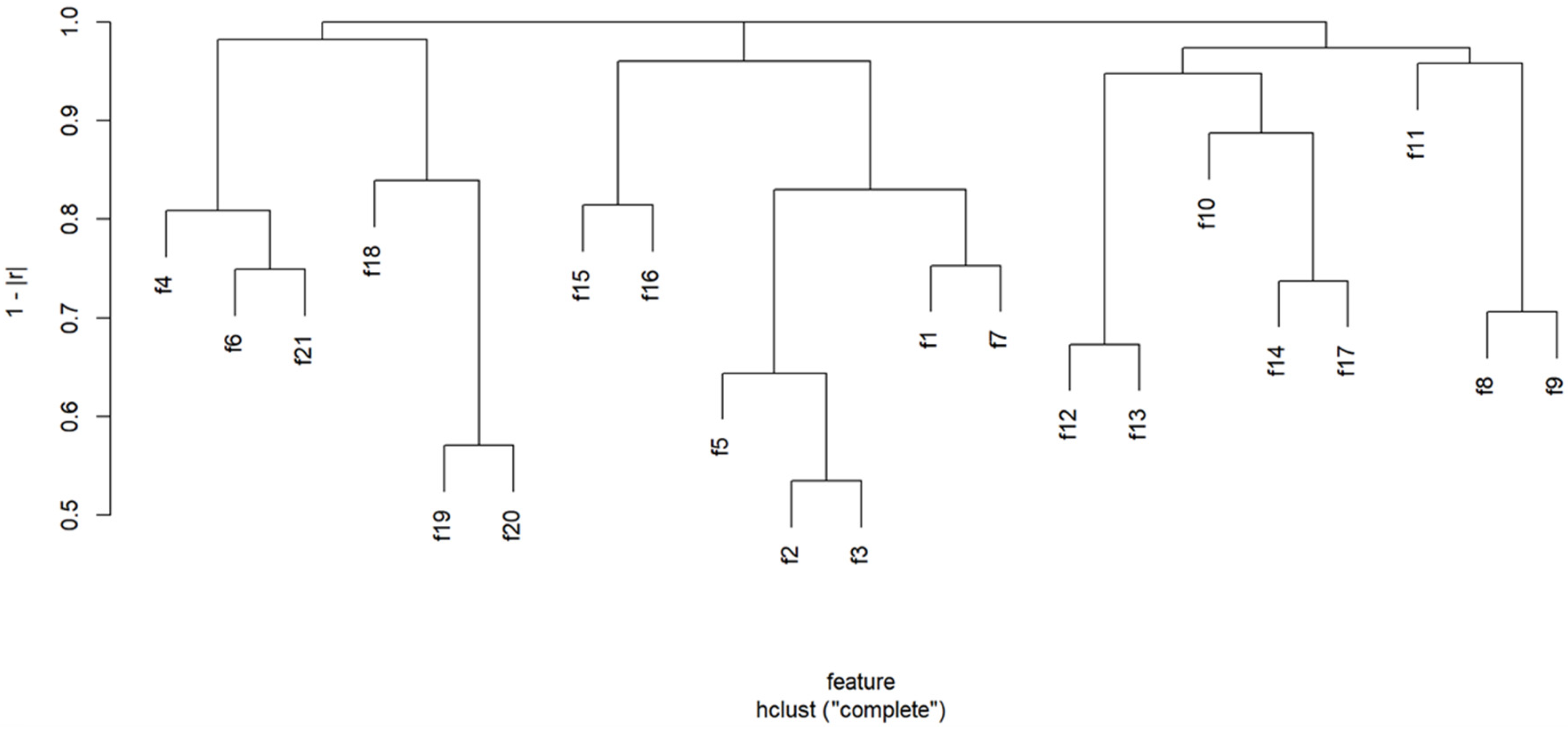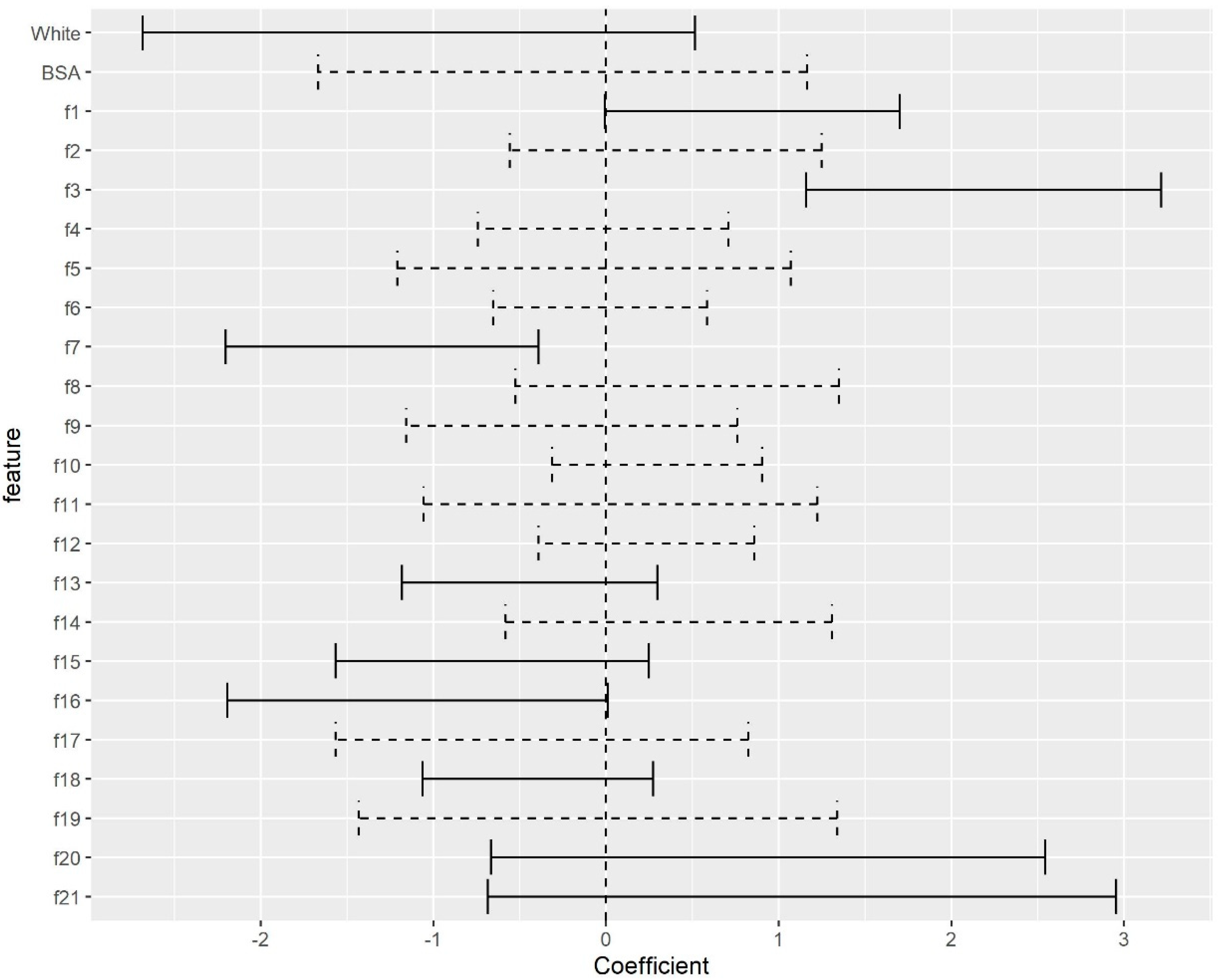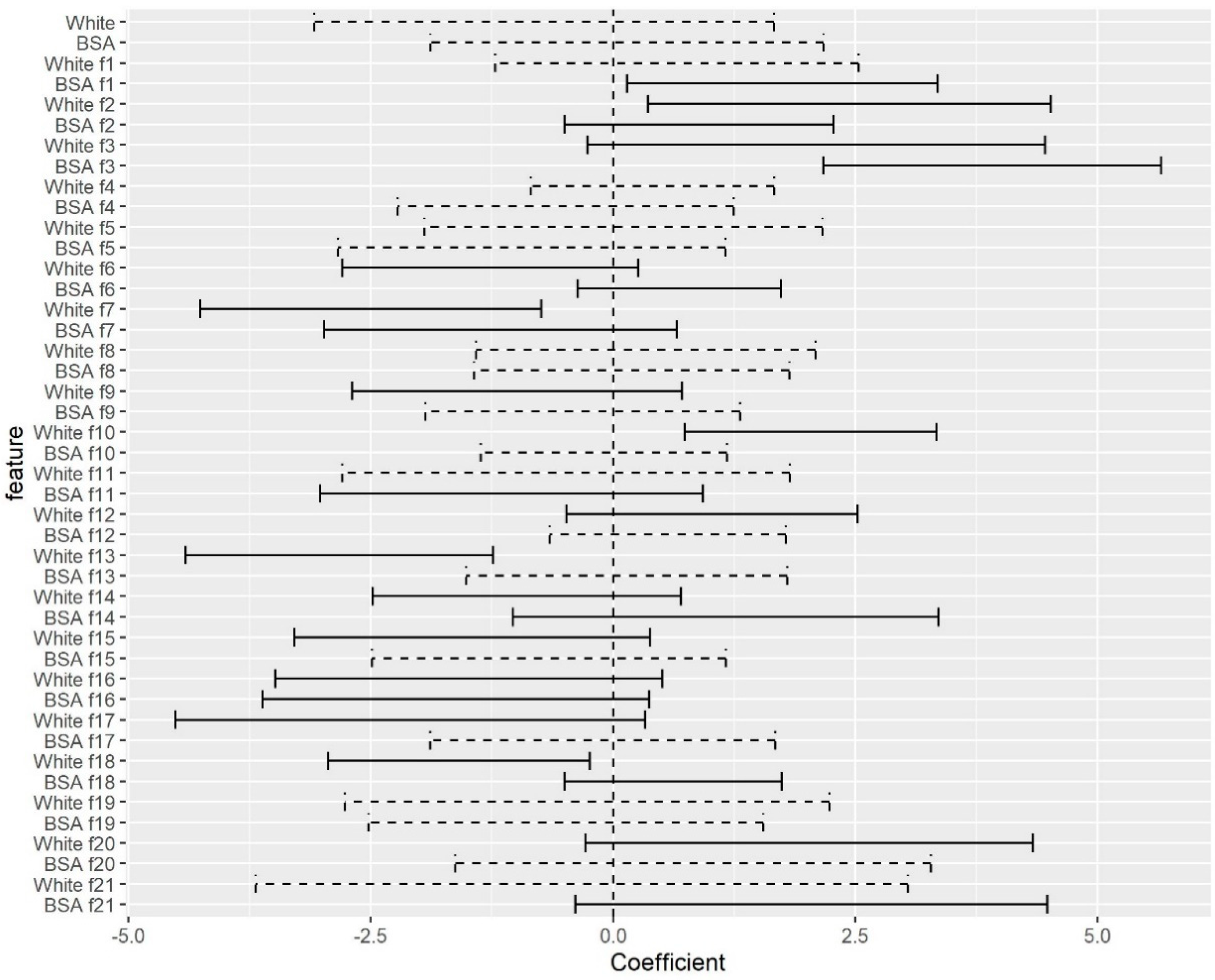Exploring the Multidimensional Characteristics of Selected and Non-Selected White British and British South Asian Youth Cricketers: An Exploratory Machine Learning Approach
Abstract
1. Introduction
2. Methods
2.1. Sample
2.2. Measures
2.2.1. Physiological and Anthropometrical
2.2.2. Perceptual–Cognitive Expertise
2.2.3. Psychological
2.2.4. Participation History
2.2.5. Socio-Cultural Influences
2.3. Procedures
2.4. Data Analysis
3. Results
4. Discussion
4.1. Athleticism
4.2. Psychological Characteristics
4.3. Wellbeing and Cohesion
4.4. Socio-Cultural
4.5. Skill
4.6. Limitations
5. Conclusions
Author Contributions
Funding
Institutional Review Board Statement
Informed Consent Statement
Data Availability Statement
Conflicts of Interest
References
- Cobley, S.; Schorer, J.; Baker, J. Identification and development of sport talent: A brief introduction to a growing field of research and practice. In Talent Identification and Development in Sport; Routledge: London, UK, 2013; pp. 21–30. [Google Scholar]
- Reeves, M.J.; Roberts, S.J. A bioecological perspective on talent identification in junior-elite soccer: A Pan-European perspective. J. Sports Sci. 2020, 38, 1259–1268. [Google Scholar] [CrossRef] [PubMed]
- McDonald, B.; Spaaij, R. Finding the ‘natural’: Talent identification and racialisation in sports coaching and selection practices in Australia. In ‘Race’, Ethnicity and Racism in Sports Coaching; Routledge: London, UK, 2020; pp. 97–111. [Google Scholar]
- Johnston, K.; Baker, J. Waste reduction strategies: Factors affecting talent wastage and the efficacy of talent selection in sport. Front. Psychol. 2018, 10, 2925. [Google Scholar] [CrossRef] [PubMed]
- Brown, T.; Khawaja, I.; Powell, A.; Greetham, P.; Gough, L.A.; Kelly, A.L. The sociodemographic profile of the England and Wales Cricket Board (ECB) talent pathways and first-class counties: Considering the British South Asian player. Manag. Sport Leis. 2021, 13, 655–669. [Google Scholar] [CrossRef]
- The Cricketer. It’s Now or Never for Asian Involvement in UK Cricket, Says Lord Patel. Available online: https://www.thecricketer.com/Topics/grassroots/it’s_now_or_never_for_asian_involvement_in_uk_cricket,_says_lord_patel.html (accessed on 19 September 2021).
- Burdsey, D. That joke isn’t funny anymore: Racial microaggressions, color-blind ideology and the mitigation of racism in English men’s first-class cricket. Sociol. Sport J. 2011, 28, 261–283. [Google Scholar] [CrossRef]
- Fletcher, T.; Piggott, D.; North, J. “The ‘blazer boys’ were getting all the chances”: South Asian men’s experiences of cricket coaching in England. Sport Soc. 2021, 24, 1472–1492. [Google Scholar] [CrossRef]
- McAuley, A.B.; Baker, J.; Kelly, A.L. Defining “elite” status in sport: From chaos to clarity. Ger. J. Exerc. Sport Res. 2022, 52, 193–197. [Google Scholar] [CrossRef]
- Jones, B.; Hardy, L.; Lawrence, G.; Kuncheva, L.; Brandon, R.; Bobat, M.; Thorpe, G. It Ain’t What You Do—It’s the Way That You Do It: Is Optimizing Challenge Key in the Development of Super-Elite Batsmen? J. Expert. 2020, 3, 144–168. [Google Scholar]
- Davids, K.; Güllich, A.; Shuttleworth, R.; Araújo, D. Understanding environmental and task constraints on talent development: Analysis of micro-structure of practice and macro-structure of development histories. In Routledge Handbook of Talent Identification and Development in Sport; Routledge: London, UK, 2017; pp. 192–206. [Google Scholar]
- Sarmento, H.; Anguera, M.T.; Pereira, A.; Araújo, D. Talent identification and development in male football: A systematic review. Sports Med. 2018, 48, 907–931. [Google Scholar] [CrossRef] [PubMed]
- Dimundo, F.; Cole, M.; Blagrove, R.; Till, K.; McAuley, A.; Hall, M.; Gale, C.; Kelly, A. Talent identification and development in male rugby union: A systematic review. J. Expert. 2021, 4, 33–55. [Google Scholar]
- Brown, T.; Kelly, A.L. Relative access to wealth and ethnicity in professional cricket. In Birth Advantages and Relative Age Effects in Sport; Routledge: London, UK, 2021; pp. 184–206. [Google Scholar]
- Sieghartsleitner, R.; Zuber, C.; Zibung, M.; Conzelmann, A. Science or coaches’ eye?–Both! Beneficial collaboration of multidimensional measurements and coach assessments for efficient talent selection in elite youth football. J. Sports Sci. Med. 2019, 18, 32. [Google Scholar]
- Kent. Pathway to the Top. Available online: https://www.kentcricket.co.uk/wp-content/uploads/Kent-Cricket-Player-Pathway-Boys.pdf (accessed on 19 September 2021).
- Brown, T.; McAuley, A.B.; Khawaja, I.; Gough, L.A.; Kelly, A.L. Talent identification and development in male cricket: A systematic review. J. Expert. 2023, 6, 176–206. [Google Scholar]
- Bangsbo, J.; Iaia, F.M.; Krustrup, P. The Yo-Yo intermittent recovery test. Sports Med. 2008, 38, 37–51. [Google Scholar] [CrossRef] [PubMed]
- Pyne, D.B.; Duthie, G.M.; Saunders, P.U.; Petersen, C.A.; Portus, M.R. Anthropometric and strength correlates of fast bowling speed in junior and senior cricketers. J. Strength Cond. Res. 2006, 20, 620–626. [Google Scholar] [PubMed]
- Glazier, P.S.; Paradisis, G.P.; Cooper, S.M. Anthropometric and kinematic influences on release speed in men’s fast-medium bowling. J. Sports Sci. 2000, 18, 1013–1021. [Google Scholar] [CrossRef] [PubMed]
- Mirwald, R.L.; Baxter-Jones, A.D.; Bailey, D.A.; Beunen, G.P. An assessment of maturity from anthropometric measurements. Med. Sci. Sports Exerc. 2002, 34, 689–694. [Google Scholar]
- Baker, J.S.; McCormick, M.C.; Robergs, R.A. Interaction among skeletal muscle metabolic energy systems during intense exercise. J. Nutr. Metab. 2010, 2010, 905612. [Google Scholar] [CrossRef]
- Barney, E.G. Preliminary Stages in the Validation of a Talent Identification Model in Cricket; Bangor University: Bangor, UK, 2015. [Google Scholar]
- Brenton, J.; Müller, S.; Harbaugh, A.G. Visual-perceptual training with motor practice of the observed movement pattern improves anticipation in emerging expert cricket batsmen. J. Sports Sci. 2019, 37, 2114–2121. [Google Scholar] [CrossRef]
- Müller, S.; Abernethy, B.; Farrow, D. How do world-class cricket batsmen anticipate a bowler’s intention? Q. J. Exp. Psychol. 2006, 59, 2162–2186. [Google Scholar] [CrossRef]
- Macnamara, Á.; Collins, D. Development and initial validation of the psychological characteristics of developing excellence questionnaire. J. Sports Sci. 2011, 29, 1273–1286. [Google Scholar] [CrossRef]
- Macnamara, A.; Collins, D. Do mental skills make champions? Examining the discriminant function of the psychological characteristics of developing excellence questionnaire. J. Sports Sci. 2013, 31, 736–744. [Google Scholar] [CrossRef]
- MacNamara, Á.; Button, A.; Collins, D. The role of psychological characteristics in facilitating the pathway to elite performance part 1: Identifying mental skills and behaviors. Sport Psychol. 2010, 24, 52–73. [Google Scholar] [CrossRef]
- Bull, S.J.; Shambrook, C.J.; James, W.; Brooks, J.E. Towards an understanding of mental toughness in elite English cricketers. J. Appl. Sport Psychol. 2005, 17, 209–227. [Google Scholar] [CrossRef]
- Bruner, M.W.; Benson, A.J. Evaluating the psychometric properties of the Social Identity Questionnaire for Sport (SIQS). Psychol. Sport Exerc. 2018, 35, 181–188. [Google Scholar] [CrossRef]
- Seers, A. Team-member exchange quality: A new construct for role-making research. Organ. Behav. Hum. Decis. Process. 1989, 43, 118–135. [Google Scholar] [CrossRef]
- Mewton, L.; Kessler, R.C.; Slade, T.; Hobbs, M.J.; Brownhill, L.; Birrell, L.; Tonks, Z.; Teesson, M.; Newton, N.; Chapman, C.; et al. The psychometric properties of the Kessler Psychological Distress Scale (K6) in a general population sample of adolescents. Psychol. Assess. 2016, 28, 1232. [Google Scholar] [CrossRef] [PubMed]
- Graen, G.B.; Uhl-Bien, M. Relationship-based approach to leadership: Development of leader-member exchange (LMX) theory of leadership over 25 years: Applying a multi-level multi-domain perspective. Leadersh. Q. 1995, 6, 219–247. [Google Scholar] [CrossRef]
- Keyes, C.L. The mental health continuum: From languishing to flourishing in life. J. Health Soc. Behav. 2002, 43, 207–222. [Google Scholar] [CrossRef] [PubMed]
- Eys, M.; Loughead, T.; Bray, S.R.; Carron, A.V. Development of a cohesion questionnaire for youth: The Youth Sport Environment Questionnaire. J. Sport Exerc. Psychol. 2009, 31, 390–408. [Google Scholar] [CrossRef] [PubMed]
- Kavussanu, M.; Boardley, I.D. The prosocial and antisocial behavior in sport scale. J. Sport Exerc. Psychol. 2009, 31, 97–117. [Google Scholar] [CrossRef]
- Boardley, I.D.; Kavussanu, M. The moral disengagement in sport scale–short. J. Sports Sci. 2008, 26, 1507–1517. [Google Scholar] [CrossRef]
- Brown, T.W.; Gough, L.A.; Kelly, A.L. Performance trajectories of bowlers and batters from youth level to senior professional status in cricket. Int. J. Perform. Anal. Sport 2022, 22, 1–15. [Google Scholar] [CrossRef]
- Dormann, C.F.; Elith, J.; Bacher, S.; Buchmann, C.; Carl, G.; Carré, G.; Marquéz, J.R.; Gruber, B.; Lafourcade, B.; Leitão, P.J.; et al. Collinearity: A review of methods to deal with it and a simulation study evaluating their performance. Ecography 2013, 36, 27–46. [Google Scholar] [CrossRef]
- Wu, H.M.; Tzeng, S.; Chen, C.H. Matrix visualization. In Handbook of Data Visualization; Springer: Berlin/Heidelberg, Germany, 2008; pp. 681–708. [Google Scholar]
- Hylton, K. Too radical? Critical race theory and sport against racism in Ireland. In Sport and Challenges to Racism; Palgrave Macmillan: London, UK, 2011; pp. 229–246. [Google Scholar]
- Scanlan, A.T.; Berkelmans, D.M.; Vickery, W.M.; Kean, C.O. A review of the internal and external physiological demands associated with batting in cricket. Int. J. Sports Physiol. Perform. 2016, 11, 987–997. [Google Scholar] [CrossRef] [PubMed]
- Kilvington, D. The “Asian Frame”, Football and the Sport Media. Netw. Knowl. J. MeCCSA Postgrad. Netw. 2012, 5, 121. [Google Scholar]
- Dugdale, J.H.; Sanders, D.; Myers, T.; Williams, A.M.; Hunter, A.M. A case study comparison of objective and subjective evaluation methods of physical qualities in youth soccer players. J. Sports Sci. 2020, 38, 1304–1312. [Google Scholar] [CrossRef] [PubMed]
- Kelly, A.L.; Williams, C.A. Physical characteristics and the talent identification and development processes in male youth soccer: A narrative review. Strength Cond. J. 2020, 42, 15–34. [Google Scholar] [CrossRef]
- Barker, J.; Slater, M. It’s not just cricket. Psychologist 2015, 28, 552–557. [Google Scholar]
- The Cricket Monthly. Being a Selector Is about Spotting Strength of Character. Available online: https://www.thecricketmonthly.com/story/967943/-being-a-selector-is-about-spotting-strength-of-character (accessed on 19 September 2021).
- Gucciardi, D.F. The relationship between developmental experiences and mental toughness in adolescent cricketers. J. Sport Exerc. Psychol. 2011, 33, 370–393. [Google Scholar] [CrossRef]
- Williams, M.J. Cricket and England: A Cultural and Social History of Cricket in England between the Wars; Routledge: London, UK, 2012. [Google Scholar]
- Fletcher, T. The making of English cricket cultures: Empire, globalization and (post) colonialism. Sport Soc. 2011, 14, 17–36. [Google Scholar] [CrossRef]
- Thomas, C.E.; Gastin, P.B.; Abbott, G.; Main, L.C. Impact of the talent development environment on the wellbeing and burnout of Caribbean youth track and field athletes. Eur. J. Sport Sci. 2021, 21, 590–603. [Google Scholar] [CrossRef]
- Ivarsson, A.; Stenling, A.; Fallby, J.; Johnson, U.; Borg, E.; Johansson, G. The predictive ability of the talent development environment on youth elite football players’ well-being: A person-centered approach. Psychol. Sport Exerc. 2015, 16, 15–23. [Google Scholar] [CrossRef]
- Andrade, A.; dos Santos Goes, Q.; Coimbra, D.R. Factors Associated with Self-Determined Motivation in Young Basketball Athletes: A Systematic Review. Revista de Psicología del Deporte. J. Sport Psychol. 2021, 30, 1–7. [Google Scholar]
- Elhadji, D. An extensive literature of Social Meaning of Eye Contact Trough the Cultures: A Cross-Cultural Comparison. Int. J. Res. Soc. Sci. 2017, 7, 374–384. [Google Scholar]
- Akechi, H.; Senju, A.; Uibo, H.; Kikuchi, Y.; Hasegawa, T.; Hietanen, J.K. Attention to eye contact in the West and East: Autonomic responses and evaluative ratings. PLoS ONE 2013, 8, e59312. [Google Scholar] [CrossRef] [PubMed]
- Cobley, S.; Wattie, N.; Baker, J.; McKenna, J. A meta-analytical review of relative age effects in sport: The emerging picture. Sports Med. 2009, 39, 235–256. [Google Scholar] [CrossRef] [PubMed]
- Connor, J.D.; Renshaw, I.; Doma, K. Moderating factors influence the relative age effect in Australian cricket. PeerJ 2019, 7, e6867. [Google Scholar] [CrossRef] [PubMed]
- Hancock, D.J.; Adler, A.L.; Côté, J. A proposed theoretical model to explain relative age effects in sport. Eur. J. Sport Sci. 2013, 13, 630–637. [Google Scholar] [CrossRef] [PubMed]
- Tribolet, R.; Watsford, M.L.; Coutts, A.J.; Smith, C.; Fransen, J. From entry to elite: The relative age effect in the Australian football talent pathway. J. Sci. Med. Sport 2019, 22, 741–745. [Google Scholar] [CrossRef]
- Weissensteiner, J.; Abernethy, B.; Farrow, D.; Müller, S. The development of anticipation: A cross-sectional examination of the practice experiences contributing to skill in cricket batting. J. Sport Exerc. Psychol. 2008, 30, 663–684. [Google Scholar] [CrossRef]
- Kelly, A.L.; Brown, T.; Reed, R.; Côté, J.; Turnnidge, J. Relative Age Effects in Male Cricket: A Personal Assets Approach to Explain Immediate, Short-Term, and Long-Term Developmental Outcomes. Sports 2022, 10, 39. [Google Scholar] [CrossRef]
- Taylor, R.D.; Collins, D.; Carson, H.J. Sibling interaction as a facilitator for talent development in sport. Int. J. Sports Sci. Coach. 2017, 12, 219–230. [Google Scholar] [CrossRef]
- Burdsey, D. British Muslim experiences in English first-class cricket. Int. Rev. Sociol. Sport 2010, 45, 315–334. [Google Scholar] [CrossRef]




| Feature | Interpretation | Contributing Factors |
|---|---|---|
| 1 | Athleticism |
|
| 2 | Exchange |
|
| 3 | Wellbeing |
|
| 4 | Peer-led practice |
|
| 5 | Practice/game skill |
|
| 6 | Kessler Psychological Distress Scale |
|
| 7 | Psychological factors | PCDEQ
|
| 8 | Sport variety/affluence |
|
| 9 | Physicality |
|
| 10 | Moral disengagement scale |
|
| 11 | Batter specialism |
|
| 12 | Prosocial behaviour |
|
| 13 | Individual practice |
|
| 14 | Brothers (older) |
|
| 15 | Brothers (younger) |
|
| 16 | Sisters (older) |
|
| 17 | Sisters (younger) |
|
| 18 | Antisocial behaviour |
|
| 19 | Birth quarter |
|
| 20 | Birth quarter |
|
| 21 | Birth quarter |
|
Disclaimer/Publisher’s Note: The statements, opinions and data contained in all publications are solely those of the individual author(s) and contributor(s) and not of MDPI and/or the editor(s). MDPI and/or the editor(s) disclaim responsibility for any injury to people or property resulting from any ideas, methods, instructions or products referred to in the content. |
© 2024 by the authors. Licensee MDPI, Basel, Switzerland. This article is an open access article distributed under the terms and conditions of the Creative Commons Attribution (CC BY) license (https://creativecommons.org/licenses/by/4.0/).
Share and Cite
Brown, T.; Cook, R.; Gough, L.A.; Khawaja, I.; McAuley, A.B.T.; Kelly, A.L. Exploring the Multidimensional Characteristics of Selected and Non-Selected White British and British South Asian Youth Cricketers: An Exploratory Machine Learning Approach. Youth 2024, 4, 718-734. https://doi.org/10.3390/youth4020048
Brown T, Cook R, Gough LA, Khawaja I, McAuley ABT, Kelly AL. Exploring the Multidimensional Characteristics of Selected and Non-Selected White British and British South Asian Youth Cricketers: An Exploratory Machine Learning Approach. Youth. 2024; 4(2):718-734. https://doi.org/10.3390/youth4020048
Chicago/Turabian StyleBrown, Tom, Robert Cook, Lewis A. Gough, Irfan Khawaja, Alexander B. T. McAuley, and Adam L. Kelly. 2024. "Exploring the Multidimensional Characteristics of Selected and Non-Selected White British and British South Asian Youth Cricketers: An Exploratory Machine Learning Approach" Youth 4, no. 2: 718-734. https://doi.org/10.3390/youth4020048
APA StyleBrown, T., Cook, R., Gough, L. A., Khawaja, I., McAuley, A. B. T., & Kelly, A. L. (2024). Exploring the Multidimensional Characteristics of Selected and Non-Selected White British and British South Asian Youth Cricketers: An Exploratory Machine Learning Approach. Youth, 4(2), 718-734. https://doi.org/10.3390/youth4020048








